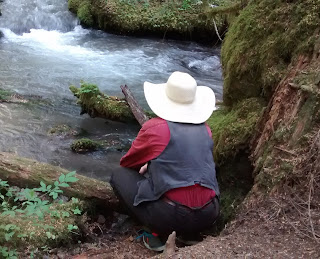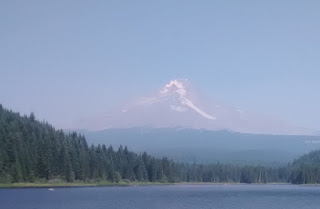 |
| Last year. |
Mary Ann and I were eager to get up to the mountain for our annual huckleberry harvest. Piecrusts get lonely. We were fully two weeks early according to historical records, but we had a premonition. Things haven’t been right. Winter started on cue last November and then it petered out. The sun swaggered in with its arms folded over its chest and shoved winter aside, glowering. Then the sun had to repeat a grade, and came back even bigger and meaner. Things started to flower and set fruit in February out of sheer submissiveness, while later the birds, sticking to their old calendar, came back from their tropical vacations and wondered where the food had gone.
Last summer we had the most stupendous huckleberry season ever. When we thumbed berries into our buckets it sounded like the drum corps in a marching band. This year it sounded like the triangle player in a mouse orchestra: ting!
…ting!
There was a berry here, and a berry there. Many of them were shriveled and disheartened. At best, they aspired to being maybe a pie in a mayonnaise jar lid. Three hours in, we could still see the bottom of our buckets. We’d have done almost as well looking for mangoes.
It’s not a good sign when you reach for your phone in the middle of your favorite huckleberry patch just to Google recipes for salal berries. There were salal berries about, but I’d never heard of anyone eating them. The internet solemnly reported that salal berries were indeed edible, and that the native Salish tribes edded them. I briefly visualized a diet for the new century featuring salal berries pounded into animal fat, tied up with entrails, and seasoned in a hide pouch. A lot like a Larabar, I figure. The internet also volunteered that the berries were useful as an appetite suppressant.
Turd pie in phlegm sauce is also, I would say, an appetite suppressant.
Our huckleberry patch is in a little hidden hollow below the main highway on the mountain. Despite the inevitable shard of plastic or a beer can flashing in the sun, it’s still a beautiful miniature. A small stream runs nearby, burbling companionably. The light is dappled and green as it sifts through the trees. Individual bushes wobble as a chipmunk races us to the last berries. A wren hops along the ground, poking for snacks in the log rot. There’s not much that moves slower than a huckleberry picker in a bad year, and the wren walks right up to us, unconcerned. There are plenty of bugs in the disintegrating woods, and she’ll be here through the winter. People are dangerous, as a group, but apparently she doesn’t stereotype.
Above us, road equipment barks and bellows, and trucks blat by with their jake brakes on. Even higher, the mountain hunkers behind a smoke shroud from one of this year’s six billion forest fires. It’s wearing dusty shreds of its remaining glaciers like an old woman clutching rags to her chest for dignity.
Down in our green bowl, Mary Ann and I are little figurines in a shoebox diorama. Huckleberry Pickers Of The Pacific Northwest: “The ancients gathered foodstuffs according to the seasons.”
We’re nearly motionless, crouched on a beautiful stage, with a smoke curtain behind us, and a wounded sky behind that. We’re a future museum exhibit. A tableau of what we’ll lose next.



There are plenty of bugs in the disintegrating woods, and she'll be here through the winter.
Have you considered searching for bug pie recipes? they couldn't be much worse than that salal hide pouch thing.
Failing that, birds are potential pie material, or at least there's an old bit of doggerel to that effect.
Even in a good year, I don't think I could reliably scoop up four-and-twenty Pacific wrens, and that would be a small pie.
Wonderful tale of the huckleberry excursion. Evoked so many images and a memory, too. Rounded a curve on a logging road above the Snohomish and behold! Huckleberries all over the hillside and I without a container. Took the hubcaps off the car. . . Fifty-eight years ago this summer.
We saw tons on Mt. Adams last week, but we couldn't see Mt. Adams. Smoke. Hubcaps! Seems like it would be a precarious ride back with those berries…
Is that lost lake? Doesn't exactly look like it, but it's been a few years.
My fav spot was at the east end of Lost Lake, maybe 100 yards in from the small bay. There was a spot of a couple acres that had a lot of berries.
Back during the depression my mother would go up there to dig rhododendron bushes up to sell in Portland to nursery's.
That's Trillium Lake, on the other side of the mountain. These days people dig up bear grass for the florists. It's amazing we have ANYTHING left.
"Turd pie in phlegm sauce." That even suppresses MY appetite. Not every year is a good berry year. We have good berries, but lousy mushrooms this year because of the timing of the rain. Can you fix that?
Apparently, I have no power over rain. Or there'd be a bunch of it happening here, I'll tell you what.
Well. That was depressing, wry smiles notwithstanding. I hope the weather improves soon. And by that I mean I hope it rains and rains and rains.
EXACTLY.
Wow the images presented here are bigger than your shoebox diorama. What museum will be there in the future?
And will we know?
Summer is frequently a surly overstayer here. And goodness is she mean.
Loved your descriptions (even those which diminished my appetite) and mourn for what wasn't there.
I'd love to come visit you if you could keep some of that torridness at bay.
Come in our winter, we get the clouds and rain, but also plenty of sunshine still.
I'd never come across "jake brakes" and wondered if it meant compression braking.Mr Google confirmed my wonderment.But, y'know, I think I'll think of it as a trucky called Jake who does not limit his compression breaking in suburban streets…
Sadly, there are little tableaux like your shoebox all over this tired old rock.But maybe next year…
Obviously the fate of this year's berries does not perfectly reflect the fate of the planet. But it does make one morose, under the right (wrong) conditions.
Shoot. That was depressing. I'm going to have to read Elizabeth Kolbert's The Sixth Extinction in order to cheer up.
Yeah, I went off the rails there, a little bit. It happens. You never know.
Seems like last year's bumper crop included this year's berries. You'll have to hope next year is another bumper.
I like your descriptions though, the burbling creek, the mountain gathering its snow like an old woman would a shawl.
I actually still have some of last year's berries! So there's still a pie possibility.
Although I don't dispute your opinion of where our planet is being driven, I can tell you that we picked berries all through my childhood and there was a lot of variation from year to year depending on when we got rain and how much and when we got sun and how much.
For a fascinating read (but long, just preparing you) here's a link (and Parts I and II are equally good, as I expect Part IV will be, once it's written):
http://waitbutwhy.com/2015/08/how-and-why-spacex-will-colonize-mars.html
It converted me to being a supporter of space exploration/colonization, and that is a huge statement (heck, I don't even like to travel to the next county) and for the first time in years it gives me hope for the human species.
You're absolutely right about the berry season variability. I wasn't on solid ground with this one, to even intimate that the berry shortage was related to anything else, and I knew it, but sometimes my mind just goes vining into desolate territory on its own. I'm with you on space exploration, but colonization? Can't we be satisfied with ruining just the one planet??
That was my thinking all along, too. Until I read this piece. It takes a long, looooooonng view, like millions of years into the future. Even if we avoid a global meltdown, what about the other, even bigger, stuff that will happen sooner or later? C'mon, Murr, have I ever steered you wrong? Give it a read 🙂
Okay, to sweeten the pot, I'll give you a preview: Part I is about Elon Musk and Part II is about his production of electric cars (Tesla S). Part III, to which I linked, is about another of Musk's big ideas: how to preserve the fragile human species in this vast universe. If none of that triggers your interest, you better check your pulse 🙂
OK, sugar, I'll try to make time for it, but man, you know? I am just not convinced that we're all that worth saving. I think that's what it comes down to.
Yeah, I know the feeling.
Sigh.
I just SO BADLY want smart people to read this stuff. And you're smart people.
But I didn't mean to be pushy. Just SO BADLY want smart people … etc.
Salal is delicious! My favourite berry! Mom called it a "SuperGrape" and cooked it, stems and all, then strained it and made salal jelly. Nothing beats it.
I never get that far; I eat them raw, when they're really ripe and finger-staining.
Well, shoot! How about that! I wonder why it isn't used more. I had a single one and thought it was just fine, but I was eating it with my face all screwed up because I wasn't sure if it was poisonous, and screwing your face up helps.
Hmmm…just noticed that my comment did not go in! And I did not even say anything bad or off color (like that would matter here!). I have been to Trillium Lake many times and enjoy the hike around it, the view, and the fishing for crawdads. I would catch them using a bit of hot dog on a fishing line hook. Did better than those who had the traps! In fact, I once placed all of mine into a trap a guy had in the water and when he came to get it he was so excited!
I think we used cat food for crawdads. And up at Burnt Lake they were so large they couldn't get through the hole in the trap. They were clinging to the outside. Or, possibly they were lobsters.
I have fond memories of chasing the wild huckle in the wooded areas around Mendocino (California). Too old to do that now but we sure had great times.
Have the huckleberries gotten too fast for you?
Thank you, your article is very good
viagra asli usa